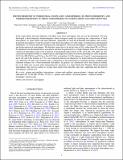PHOTOCHEMISTRY IN TERRESTRIAL EXOPLANET ATMOSPHERES. III. PHOTOCHEMISTRY AND THERMOCHEMISTRY IN THICK ATMOSPHERES ON SUPER EARTHS AND MINI NEPTUNES
Author(s)
Hu, Renyu; Seager, Sara
DownloadHu-2014-PHOTOCHEMISTRY IN TE.pdf (1.321Mb)
PUBLISHER_POLICY
Publisher Policy
Article is made available in accordance with the publisher's policy and may be subject to US copyright law. Please refer to the publisher's site for terms of use.
Terms of use
Metadata
Show full item recordAbstract
Some super Earths and mini Neptunes will likely have thick atmospheres that are not H2-dominated. We have developed a photochemistry-thermochemistry kinetic-transport model for exploring the compositions of thick atmospheres on super Earths and mini Neptunes, applicable for both H2-dominated atmospheres and non-H2-dominated atmospheres. Using this model to study thick atmospheres for wide ranges of temperatures and elemental abundances, we classify them into hydrogen-rich atmospheres, water-rich atmospheres, oxygen-rich atmospheres, and hydrocarbon-rich atmospheres. We find that carbon has to be in the form of CO2 rather than CH4 or CO in a H2-depleted water-dominated thick atmosphere and that the preferred loss of light elements from an oxygen-poor carbon-rich atmosphere leads to the formation of unsaturated hydrocarbons (C2H2 and C2H4). We apply our self-consistent atmosphere models to compute spectra and diagnostic features for known transiting low-mass exoplanets GJ 1214 b, HD 97658 b, and 55 Cnc e. For GJ 1214 b, we find that (1) C2H2 features at 1.0 and 1.5 μm in transmission and C2H2 and C2H4 features at 9-14 μm in thermal emission are diagnostic for hydrocarbon-rich atmospheres; (2) a detection of water-vapor features and a confirmation of the nonexistence of methane features would provide sufficient evidence for a water-dominated atmosphere. In general, our simulations show that chemical stability has to be taken into account when interpreting the spectrum of a super Earth/mini Neptune. Water-dominated atmospheres only exist for carbon to oxygen ratios much lower than the solar ratio, suggesting that this kind of atmospheres could be rare.
Date issued
2014-03Department
Massachusetts Institute of Technology. Department of Earth, Atmospheric, and Planetary Sciences; Massachusetts Institute of Technology. Department of PhysicsJournal
Astrophysical Journal
Publisher
Institute of Physics/American Astronomical Society
Citation
Hu, Renyu, and Sara Seager. “PHOTOCHEMISTRY IN TERRESTRIAL EXOPLANET ATMOSPHERES. III. PHOTOCHEMISTRY AND THERMOCHEMISTRY IN THICK ATMOSPHERES ON SUPER EARTHS AND MINI NEPTUNES.” The Astrophysical Journal 784, no. 1 (March 5, 2014): 63.
Version: Final published version
ISSN
0004-637X
1538-4357